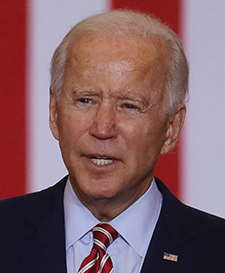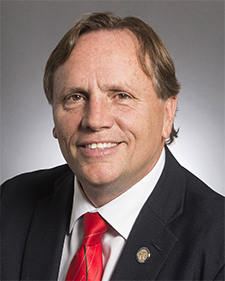As public life shuttered in the early months of the COVID-19 pandemic, Democratic U.S. Sens. Tina Smith and Elizabeth Warren proposed a $50 billion plan aimed at helping child care providers who faced dropping enrollment that threatened the industry’s survival.
It took nearly a year, but Smith and Warren’s child care bailout is now largely a reality. The massive $1.9 trillion federal stimulus package approved by Congress last week and signed into law Thursday by President Joe Biden includes more than $40 billion for child care providers across the country.
State officials estimate Minnesota will get roughly $550 million to spend on child care providers and families, a sum that industry advocates say is a stunning windfall of cash to help a service that is crucial to the state’s economic success.
“This is going to make a huge difference in terms of staunching the departure of child care centers and providers from the field,” Smith said in an interview Thursday. “Giving us time to figure out what we need to do long-term to make sure that we have a functioning child care system for moms and dads and kids.”
While the money has been celebrated by those in child care, it has also quickly raised questions locally over how best to use the stimulus. Nationally, some have raised concerns over whether the child care system can even handle the flood of cash.
“Everybody asks for money and they celebrate getting it, and nobody knows how it’s going to be spent,” said Cindy Lehnhoff, director of the National Child Care Association (NCCA). “That’s a huge frustration I have as an advocate.”
Why Smith pushed for child care money
Even before the pandemic, affordable child care was scarce in much of Minnesota and the nation. The economics of the industry cause providers to get paid very little while tuition costs for families can be enormous.
Then, when governors around the country announced new restrictions on public life at the beginning of the COVID-19 pandemic, child care providers were put in a tricky spot. Asked to stay open to serve children of essential workers, they also faced declining enrollment and rising sanitation costs that burdened an industry that already operates on razor-thin margins.
In April of 2020, Smith and Warren first proposed their child care bailout, aiming for $50 billion to keep providers afloat. Smith said “child care is the basic infrastructure of our economy and infrastructure for families.”
“If it isn’t there, the economy doesn’t work,” Smith said.
Under then-President Donald Trump, stimulus packages did provide infusions of cash for the industry. There was $3.5 billion for child care in the $2.2 trillion CARES Act in March of 2020, according to Smith’s office, and another $10 billion in the $900 billion December stimulus.
The state of Minnesota, which also set aside money for child care, distributed a large portion of the relief funding over the summer through direct grants to struggling child care businesses. It was enough to stave off a crash of providers. But the industry is still shaky, and economic problems that existed before the pandemic remain.
Smith said “we are starting to turn the corner in some places,” but Minnesota still has a “huge shortage of child care centers and child care providers, and a lot of providers that are really struggling to figure out whether they can even stay open.”

For context, in its 2020 fiscal year, the federal government sent a total of $8.7 billion to states, territories and tribes through the Child Care and Development Block Grant, which provides subsidies for low-income families with children under the age of 13. The new stimulus package will give roughly $15 billion more to that program, plus another $24 billion for child care “stabilization funding” and another $1 billion for the Head Start program.
Of the newly available federal funds, state officials office estimated $550 million will go to Minnesota child care. About $203 million will be allocated for the Child Care and Development Block Grant, while Minnesota will get $325 million for child care stabilization funds, $11.75 million for Head Start and $9.2 million for child care funding connected to the Temporary Assistance for Needy Families program.
Competing ideas on how to spend the money
Though most national child care organizations and advocacy groups say the new surge of money is a win for U.S. child care, some worry the huge influx of cash may actually overwhelm the systems traditionally used to distribute federal assistance.
Lehnhoff, the director of the NCCA, met with members of her staff and other child care organizations last week to discuss plans for managing the new influx of money from the stimulus package.
“I asked the question, ‘What’s the plan for spending 10 times the amount of money we would typically get in one year?’ And there’s dead silence. The issue is how is it going to be spent and who will plan that,” Lehnhoff said.
Despite concerns about handling this huge influx of funds at the national level, Ann McCully, executive director of the prominent advocacy nonprofit Child Care Aware of Minnesota, is not so worried. She says Minnesota already has a track record of using support funds efficiently.
“I am not concerned about our ability to build on what we’ve already built,” McCully said. “We have a lot of existing programs being expanded.”
In Minnesota, officials at the Department of Human Services say the Walz administration has legislative authority to distribute the federal stimulus money. While DHS does not have any concrete plans for how to use any of the funds yet, and state officials and legislators say they’re still learning about federal constraints on how the money can be used, the agency is consulting with industry interest groups, legislators and others about how to move forward with cash in hand.
There is no shortage of ideas.
McCully, for one, said the state should consider ways to increase the number of child care providers in addition to giving more money to existing ones. McCully also said the level of funding through the Child Care and Development Block Grant is only enough to serve about one out of six children living below the poverty line — the demographic it was created to serve. Minnesota can reach more of those children with the new federal funding, she said.
“Compensation would also be fabulous,” McCully said. Child Care Aware of Minnesota provides bonuses to some child care providers to encourage them to stay in the often low-paying field, but those recipients cannot receive the bonus two years in a row, and historically only about 25% of people who apply are able to be funded.
“What we hear from [recipients] is it makes so much difference, enough so that they can pay the bills. These grants fill the gap between woefully low wages and what they probably should have to live,” McCully said.
Clare Sanford, government relations chair for the Minnesota Child Care Association, which represents owners of private centers, said the money shouldn’t just be used for grants to help providers with current operating costs related to COVID-19, which much of past state and federal assistance during the pandemic has been used for.
Sanford said the state could also increase reimbursement payments to child care providers under the Child Care Assistance Program, the state’s primary subsidy for low-income families. CCAP served about 30,700 Minnesota children each month in the 2019 fiscal year, at an annual cost of $250 million. Nearly all of that money is split between the state and federal government, though county governments pick up a small portion.
Federal money could also potentially be used to expand eligibility for that program, she said. And Sanford said increasing CCAP payments is one way the state could try to hike wages for child care workers.
“The quickest and most efficient way to help the child care crisis in all 87 counties is to just put money into the (CCAP) program,” Sanford said. “Our reimbursement rates are terrible, they’re still some of the worst in the nation.”
Minnesota has failed to meet federal recommendations for reimbursement in the CCAP program for years and has only recently come into temporary compliance with minimum standards. The feds want reimbursement payments high enough to cover the full cost of child care at roughly three in four providers in a market. In 2020, using money from the CARES Act, state lawmakers increased Minnesota’s reimbursement payments to meet the lowest possible rate required: enough to cover the full cost of care at roughly one in four providers in a market.
While advocacy groups interested in child care have often been split over where the state should invest money to help fix problems in the industry, many have come together this year to advocate for more cash in CCAP, which has tended to attract support mostly from Democrats. The coalition of groups is also asking for more money for early learning scholarships, which Republicans have favored. Administered by the state Department and Education, the scholarships give parents money to help them pay for high-quality child care programs.
State legislators also have ideas
State Sen. Jim Abeler, an Anoka Republican who chairs the Senate’s Human Services Reform Finance and Policy Committee, also said he hopes the money isn’t spent entirely on grants to help child care providers with current operating costs. Rather, he wants to spend the money in a way that can help boost the number of child care providers and provide lasting impact, especially in rural areas where there is a lack of early learning services now.

While DHS says it can spend the federal money, the politically divided Legislature could always pass a law aiming to direct the stimulus. “It’s my intention to give some guidance to the state about how they might want to invest that well,” Abeler said.
State Rep. Dave Pinto, a St. Paul DFLer who chairs the Early Childhood Finance and Policy Committee, said the federal cash is welcome after years of underinvestment in a child care system critical to economic development and long-term educational success for kids. Pinto said his committee has heard proposals to increase CCAP reimbursement rates to meet federal recommendations, give more money to early learning scholarships and more — all areas he said federal funding could address.
Still, Pinto said he’s waiting for more details about the stimulus money and isn’t focused on closely directing Walz’s spending. “There’s a lot that the administration would want to do with those funds that I will be very much in support of,” Pinto said.

Smith said she hopes the federal government also continues to address issues in the child care industry such as low wages for providers. “There’s a real shortage of providers and educators,” Smith said. “So it’s a complicated problem and there isn’t going to be just one solution to it. The way that we got this done in these bills was just to keep the focus on and remind people that if there isn’t a child care system, the economy is not going to recover.”


0 Commentaires